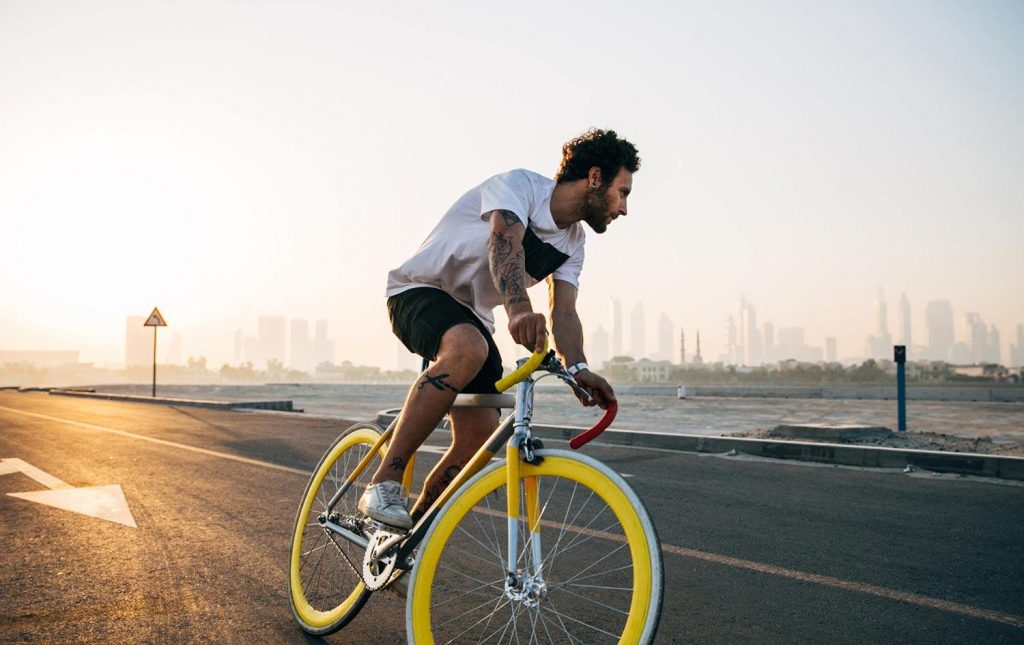With a comprehensive preparation plan put together well in advance, you can maximise your chances of success in your first cycling race. Preparation, planning the training, nutrition, tips, equipment, here are some tricks to prepare for your bike race.
Anticipation: the key to success

Your first cycling race is an important event: you have everything to gain by anticipating its preparation several months in advance. By planning a complete schedule that includes an assessment of your strengths and weaknesses, training sessions up to the day of the race with targeted exercises, testing your stress reaction, an analysis of the racing track, and not forgetting the rest periods that are necessary to stay in top shape, you will no doubt have a lot of fun!
The different stages of training
As soon as you know the date of the race, check its specific details so you can adjust your training plan accordingly:
- Check the race track: the route’s elevation, the track’s length, the season, the weather…
- Technical aspects to consider: sprint, time trial, recovery…
- The necessary equipment and clothing: is your bike in good condition? Do you need specific technical equipment or clothing to take part in this race? Are you equipped with a water bottle and well protected?
Next, break down your training plan into several stages, spread out over several months depending on the level of effort to be made during the race. The training stages are divided into blocks, with a few days of rest between each one. Here is an example of a 4-step plan:
- Workouts, 5 to 6 weeks: gradually increase the frequency of training, with priority given to endurance and fitness improvement. This can be done through weight training or other physical activities in addition to your bike or home training workouts.
- The groundwork, 9 to 10 weeks: at this stage, you are at the heart of the training, your cardio capacity and resistance to exercise are optimal thanks to the workouts done in the first few weeks. You will gradually improve your performance and begin increasing your workouts as the weeks go by.
- Technical aspects and targeted training, 3 to 4 weeks: now you are ready to tackle the most technical aspects to be mastered during the race, such as sprints, acceleration, time trial training, uphill training…
- Maintain and sharpen your fitness level, 2 to 3 weeks: a few weeks before the day of the race reduce your workouts and take care of yourself, to make sure you are well-rested and fit on the day of the race.
Recovery: an important part of preparation
The last stage is dedicated to recovery,, which is very important for a good race progress. After several months of exercising tirelessly, the body could need to recharge and rebuild. You’ll likely want to do this for your own benefit as the build up to race day approaches.
During this period, the frequency of the workout sessions can be halved, by spacing them out over the week. It is much more important to reduce the amount of training rather than its intensity, in order not to lose the benefits of your hard work from the previous months.
The final stretch: the release exit
The day before the race, a release exit is often performed: this is where you will test all the previously learned training stages, whether it’s the technical aspects or the different exercise intensities that you will encounter during the race. It is a matter of readjusting the body to the training after a period of balancing, both on the cardiovascular and muscular levels. The training session can be broken down as follows:
- A 15-minute warm-up.
- Alternate in split work based on 20 seconds of workouts, 40 seconds of recovery, with 3 or 4 repetitions, the goal being to reach about 90% of your maximum heart rate.
- Velocity training, i.e. pedalling at high speed with leg mobilisation, for about 10 minutes.
- New round of accelerations of about 20 seconds, with each time being 40 seconds at a slower speed to recover
- Cool down for 15 minutes at a moderate pace
Incorporate nutrition into your cycling race preparation

Throughout the preparation, also think about adapting your diet to provide your body with the necessary energy according to the different stages of training. Balance your menus by eating everything in controlled portions, divided into 3 or 4 meals during the day. Hydration, before, during and after exercise is also essential: if you are constantly on the go, even on days when you are not training, frequent hydration of 1.5 litres per day will quickly become a habit.
- 1 to 2 weeks before the race, start adding more starchy foods to your diet: pasta, rice, bread, semolina, corn, etc…
- The day before the event, low sugar foods are also welcome on your plate, as are fresh vegetables, avoiding fat and foods that are too sweet and including a portion of lean protein such as white meat for example.
- On the big day, do not eat anything from one hour before the race.
- If the race is a long one, include a cereal bar or dried fruit to prevent your blood sugar levels from dropping. An energy gel may also help, as well as water or a sports drink rich in minerals and carbohydrates.
- After the race, hydrate to replace the water lost due to perspiration. Have a quick intake of carbohydrates, either to drink or as a light snack such as compote. Within an hour after the race, a sports cereal bar will also provide you with some protein.
How can a home-trainer help you prepare for a cycling race?

To diversify your training and have total control over each preparation stage, have you considered equipping yourself with a home-trainer? With a premium exercise bike that’s permanently accessible at home, you will be able to set up a flawless workout schedule, whenever you want and whatever the weather conditions are.
NordicTrack’s Biking Series offers state-of-the-art features, with many resistance levels, elevation management from -10% to +20% and a feeling similar to a real road ride. Combine strength and power with a cycling bike for authentic sessions with a speed similar to that of a racing bike. Recumbent Series bikes are both ergonomic and sturdy, surprisingly high performance and ideal for continuing to train at home with a more comfortable posture.
With iFit® virtual coaching,, get access to specific sessions to work on speed, endurance, sprinting and uphill training. Complete real-life tracks with precise elevation control thanks to synchronisation with Google Maps. All models in the Classic Series, as well as the VXR475 in the Recumbent Series, are compatible withBluetooth® iFit®.
Well trained and motivated, you’re now fully prepared to live unforgettable moments: good luck on your first cycling race, you’re now ready to take on all challenges!
iFIT sold separately. Cancel at any time. Credit Card required for activation. Internet and Wi-Fi required.
Check out our Fitness & Training page for more advice.
